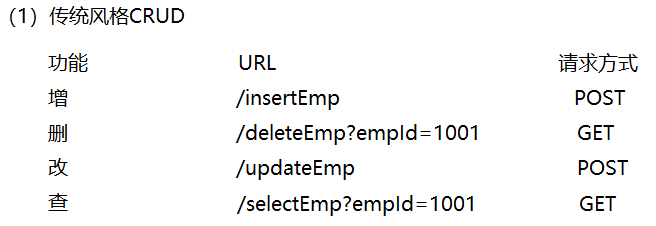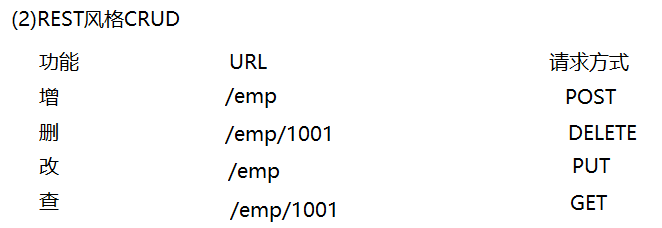2023-01-19
一、@PathVariable注解基本使用
1、获取URL中占位符
2、占位符语法:{}
3、实例代码:
@RequestMapping("testPathVariable/{empId}")
public String testPathVariable(@PathVariable("empId")Integer empId){
System.out.println(" empId = " + empId);
return SUCCESS;
}
<a th:href="@{/EmpController/testPathVariable/1001}">测试testPathVariable</a><br>
二、@PathVariable注解属性
1、value属性
(1)类型:String
(2)作用:设置占位符中的参数名
2、name属性
(1)类型:String
3、required属性
(1)类型:boolean
(2)作用:设置当前参数是否必须入参
①true:表示当前参数必须入参,如未入参数会报以下错误
Missing URI template variable 'empId' for method parameter of type Integer
②false:表示当前参数不必须入参,如未入参,会装配null值
三、REST风格CRUD概述
1、REST的CRUD与传统风格CRUD对比


2、REST风格CRUD优势
(1)提高网站排名
排名方式:
①竞价排名
②技术排名
(2)便于第三方平台对接
四、SpringMVC环境搭建
五、REST风格CRUD练习——查询
六、实现PUT&DELETE提交方法步骤
1、注册过滤器HiddenHttpMethodFilter
2、设置表单的提交方法为POST
3、设置参数:_method=PUT或_method=DELETE
七、源码解析HiddenHttpMethodFilter
public static final String DEFAULT_METHOD_PARAM = "_method";
private String methodParam = "_method";
protected void doFilterInternal(HttpServletRequest request, HttpServletResponse response, FilterChain filterChain) throws ServletException, IOException { HttpServletRequest requestToUse = request; if ("POST".equals(request.getMethod()) && request.getAttribute("javax.servlet.error.exception") == null) { String paramValue = request.getParameter(this.methodParam); if (StringUtils.hasLength(paramValue)) { String method = paramValue.toUpperCase(Locale.ENGLISH); if (ALLOWED_METHODS.contains(method)) { requestToUse = new HiddenHttpMethodFilter.HttpMethodRequestWrapper(request, method); } } } filterChain.doFilter((ServletRequest)requestToUse, response); }
private static class HttpMethodRequestWrapper extends HttpServletRequestWrapper { private final String method; public HttpMethodRequestWrapper(HttpServletRequest request, String method) { super(request); this.method = method; } public String getMethod() { return this.method; } }
八、SpringMVC处理请求数据
1、使用Servlet处理请求数据
(1)请求参数
Spring param = request.getParameter();
(2)请求头
request.getHeader()
(3)Cookie
request.getCookies();
2、处理请求参数
(1)默认情况:可以将请求参数名,与入参参数名一致的参数,自动入参(自动类型转换)。
(2)@RequestParam注解
①作用:如请求参数与入参参数
②属性
value:是String类型;作用:设置需要入参的参数名
name:是String类型;作用:与value属性作用一致
required:是Boilean类型;作用:设置当前参数,是否必须入参
defaultValue:是String类型;作用:当装配数值未null时,指定当前defaultValue默认值
九、处理请求头
1、语法:@RequestHeader注释
2、属性
(1)value:
①类型:String
②作用:设置需要获取请求头名称
(2)name:
①类型:String
②作用:与value属性作用一致
(3)required:
①类型:Boilean
②作用:设置当前参数,是否必须入参
(4)defaultValue:
①类型:String类型
②作用:当装配数值未null时,指定当前defaultValue默认值
十、处理Cookie信息
1、语法:@CookieValue获取Cookie数值
2、属性:同上
3、实例代码:
<a th:href="@{/setCookie}">设置Cookie</a> <a th:href="@{/getCookie}">获取Cookie</a>
@RequestMapping("/setCookie")
public String setCookie(HttpSession httpSession){
System.out.println("httpSession.getId() = " + httpSession.getId());
return SUCCESS;
}
@RequestMapping("/getCookie")
public String getCookie(@CookieValue("JSESSIONID")String cookieValue){
System.out.println("cookieValue = " + cookieValue);
return SUCCESS;
}